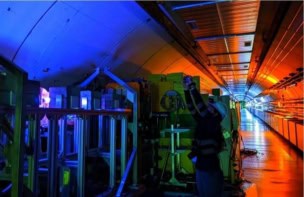Construction of the Large Hadron Collider (LHC) and its detectors at the CERN laboratory in Geneva is a challenge of Himalayan proportions. The LHC will collide protons at energies of 14 TeV (14 million million electrons volts) and two detectors - ATLAS and CMS - will survey the debris of these collisions for signs of the Higgs boson, supersymmetric particles, large extra dimensions and other evidence of new physics beyond the Standard Model.
Two further experiments will probe the differences between matter and antimatter, and the properties of quark–gluon plasmas produced in even more energetic collisions between nuclei. Due to come online in 2007, the LHC will become the focus of attention for the international particle-physics community for the best part of a decade.
Since 1991, when the lab’s council first agreed that the LHC was “the right machine for the future of CERN”, the project has been presided over by three particle physicists turned director generals — Carlo Rubbia, Chris Llewellyn Smith and Luciano Maiani. Next January, however, the baton will pass to Robert Aymar, the plasma physicist who is currently leader of the ITER fusion project.
Some will express surprise that the biggest job in particle physics has gone to a non-particle physicist. However, CERN already has plenty of particle physicists and what the lab needs now is someone with experience of managing and delivering large complex projects on schedule and within budget. And if Aymar can successfully conclude his time at ITER by persuading the project’s members to build the $4bn tokamak reactor, the fusion community in turn will need someone else with the same skills.
Moreover, Aymar is no stranger to the Geneva laboratory. In 1993, for instance, he chaired an external review committee that examined the technical feasibility of the LHC and concluded that the project should be approved. And when budget problems emerged on the project in 2001, Aymar was called in to head another external review committee. Putting his own recommendations into practice will therefore be a top priority for the new director general.
This month is also the 20th anniversary of CERN’s finest moment. In a famous seminar at the Geneva laboratory in January 1983, Carlo Rubbia of the UA1 collaboration presented evidence for the production of W bosons in collisions between protons and antiprotons. The discovery of the Z boson quickly followed and a year later Rubbia and Simon van der Meer shared the Nobel prize for their roles in the discoveries. In addition to leading the UA1 experiment, Rubbia had also been a driving force behind the construction of a proton–antiproton collider — a concept that he had proposed with two colleagues, David Cline and Peter McIntyre — while van der Meer had made it possible to produce a sufficiently strong beam of antiprotons for the experiments.
Today we take the W and Z bosons for granted as part of the Standard Model, but back in the early 1980s they were still just theoretical predictions. Their detection was a seminal moment in the history of particle physics, and also the first time that CERN — which had a reputation for losing out on big discoveries to less conservative labs — had beaten its US rivals to a major discovery. This time the race for the prize was between two experiments at CERN — UA1 and UA2. On page 23 of this month’s magazine, science writer Gary Taubes describes how UA1 was first past the post. The article is based on a chapter of Nobel Dreams, a book that Taubes wrote in 1986; sadly this engrossing read is currently out of print. And on page 29 Peter Renton explains how the latest results on the W boson from CERN and FermiLab in the US are pushing the Standard Model to the limit.
Building the LHC will also push CERN and its new director general to the limit, but the light at the end of the tunnel — the Higgs, supersymmetry and who knows what else — will be worth it.



